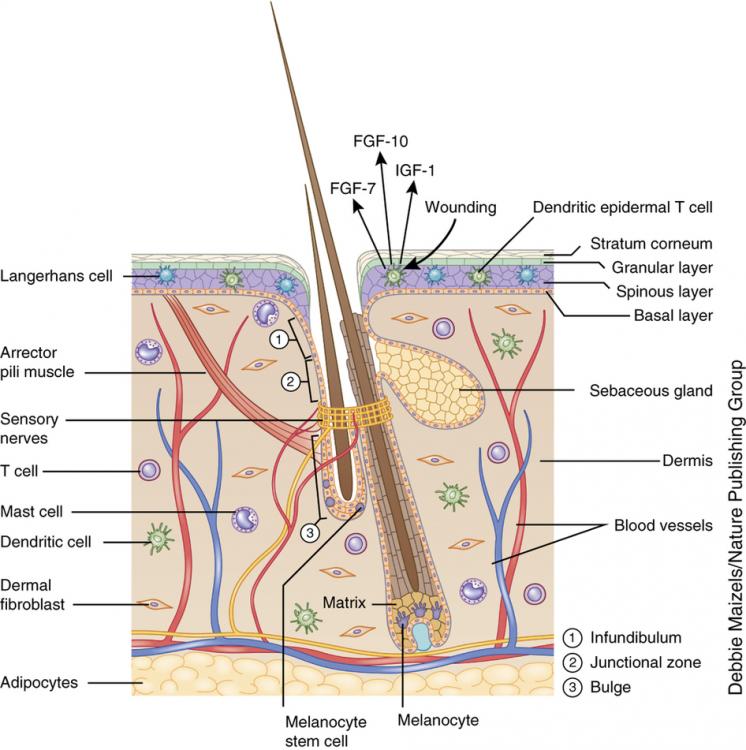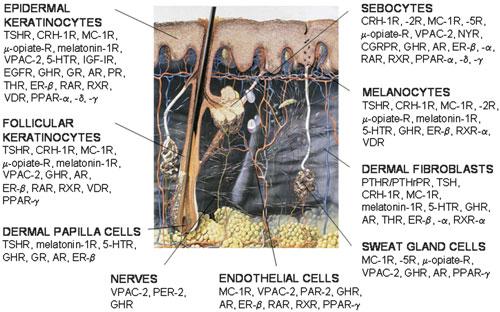Can someone please explain to me the difference between having oily skin from GENETICS and having oily skin because of hormones? How does this relate to androgens?
I don't understand... from everything I've read it's pretty clear some people just have larger sebaceous glands and therefore produce more oil. But sebum production is caused by excess androgens. SO if someone is taking an anti-androgen (for example spiro)..which blocks androgens..would the oily skin not stop regardless of if it's caused by hormones OR genetics?
I'm so sorry if that's not correct or makes no sense..if anyone can help me understand this I'd appreciate it!!
Oily skin that is mediated by genetic factors would be described as something that causes over expression of an associate gene that ensues in sebum overproduction. An example would be a mutation to the gene EPGN causes mRNA over expression, sometimes described as over-excitability, that further downstream in it's signal transmission causes our sebaceous glands to secrete too much sebum.[1] Off the top of my head I think one type of disorder relating to this activity is termed, Sebaceous Hyperplasia. Hyperplasia is the proliferation of cells via cellular division. Not to be confused with the cellular adaptation hypertrophy which relates to an increase in size and potential workload of organelles e.g cytoplasm/sarcoplasm, endoplasmic reticulum/sarcoplasmic reticulum, mitochondrial population..
Hormonal acne would be considered an instance of too much activity relating to our AR population within the skin.[2] (AR means androgen receptor. However the receptors pertaining to our epidermis/dermis are titled membrane androgen receptors mAR in comparison to standard AR which is a type of nuclear receptor.) In both males and females we have testosterone and it's generally recognized as having an anabolic/androgenic ratio of 1:1, but periodically a percentage of the free testosterone is converted via our 5au-reductase enzyme into a more androgenic potent form dihydrotestosterone. (DHT) DHT is responsible for quite a bit of androgenicity and can be stated as a major factor in MPB stemming from androgen-mediated alopecia as well as hyperandrogenism that can be experienced in females suffering from PCOS.
Highlighting the provided anatomical illustrations it would be correct to say that too much receptor activity relating to our AR pertaining to epidermal keratinocytes results in hyperkeratinization; at our sebocytes is causes oversecretion of sebum. It goes on further, but I would consider those to be the most relevant to your question.
[1]
[2]
I recommended reading a little into this-
On the topic of pharmacology relating to Spironolactone it's difficult to label it as just an anti-androgen. It's fairly complicated to explain the pharmacodynamics. I tried to before, but I felt it only complicated the subject more. P.M if you want further explanations.
i had oily skin since elementary school. on all the photos from that time the other children hadsoft matte skin while i looked like a grease ball. my grandmother is very old yet her skin is extremely oily, so it must be the genetics. but mybreakouts are hormonal. oily skin alone does not create acne. it is because of inflammation inside the skin. i don't think it is possible to turn oily skin into normal skin permanently. people with genetically dry skin can never get oily skin either
On 10/6/2015 at 4:28 PM, BaxterMcDoobinson said:Oily skin that is mediated by genetic factors would be described as something that causes over expression of an associate gene that ensues in sebum overproduction. An example would be a mutation to the gene EPGN causes mRNA over expression, sometimes described as over-excitability, that further downstream in it's signal transmission causes our sebaceous glands to secrete too much sebum.[1] Off the top of my head I think one type of disorder relating to this activity is termed, Sebaceous Hyperplasia. Hyperplasia is the proliferation of cells via cellular division. Not to be confused with the cellular adaptation hypertrophy which relates to an increase in size and potential workload of organelles e.g cytoplasm/sarcoplasm, endoplasmic reticulum/sarcoplasmic reticulum, mitochondrial population..
Hormonal acne would be considered an instance of too much activity relating to our AR population within the skin.[2] (AR means androgen receptor. However the receptors pertaining to our epidermis/dermis are titled membrane androgen receptors mAR in comparison to standard AR which is a type of nuclear receptor.) In both males and females we have testosterone and it's generally recognized as having an anabolic/androgenic ratio of 1:1, but periodically a percentage of the free testosterone is converted via our 5au-reductase enzyme into a more androgenic potent form dihydrotestosterone. (DHT) DHT is responsible for quite a bit of androgenicity and can be stated as a major factor in MPB stemming from androgen-mediated alopecia as well as hyperandrogenism that can be experienced in females suffering from PCOS.
Highlighting the provided anatomical illustrations it would be correct to say that too much receptor activity relating to our AR pertaining to epidermal keratinocytes results in hyperkeratinization; at our sebocytes is causes oversecretion of sebum. It goes on further, but I would consider those to be the most relevant to your question.
[1] http://www.ncbi.nlm.nih.gov/pmc/articles/PMC4135600/
[2] http://www.ncbi.nlm.nih.gov/pubmed/1830074I recommended reading a little into this- Sebaceous Gland: Anatomy, physiology, and possible role in pathogenesis of acne.
On the topic of pharmacology relating to Spironolactone it's difficult to label it as just an anti-androgen. It's fairly complicated to explain the pharmacodynamics. I tried to before, but I felt it only complicated the subject more. P.M if you want further explanations.
wow you know your science!
 Acne.org Products
Acne.org Products
